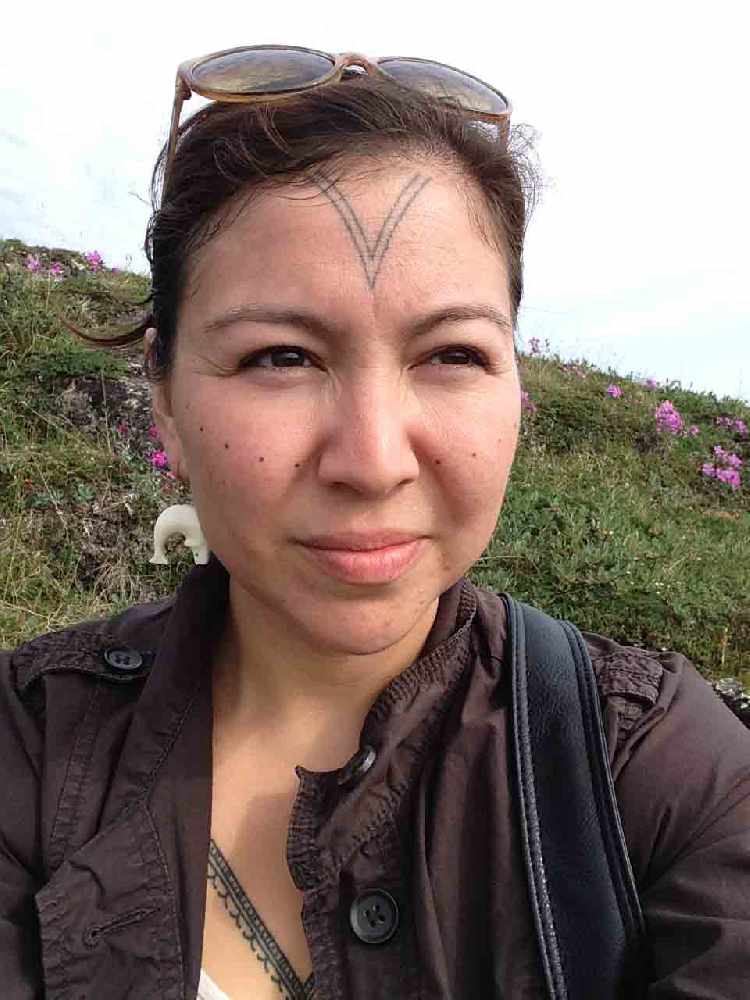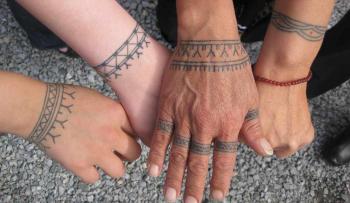Image Caption
By Andrea Smith
Windspeaker.com Contributor
NIMKII AAZHIBIKONG, Ont.
There’s been a resurgence of traditional Indigenous tattooing. That’s the belief of members of the Onaman Collective—Christi Belcourt, Isaac Murdoch, and Erin Konsmo—who are holding a gathering in honor of this.
The goal of their gathering is to bring together interested artists, the tattooed, and the tattoo-ers, to strengthen the resurgence and share the underlying meanings of it with each other.
“It seems like with tattooing, there’s many reasons why people historically tattooed… why our ancestors tattooed… and those are awakening now. We’re going to be sharing all of these things, plus including just general discussion on safety methods and modern practices, and issues of appropriation as well,” said Christi Belcourt of Onaman.
The event takes place Sept. 29 and Sept. 30, with the artists gathering on Sept. 28. And it’s being held in a relatively remote location, just north of Elliot Lake, called Nimkii Aazhibikong.
The Onamen Collective crew normally hosts their language immersion camp there, and they favor the remoteness because, as Belcourt puts it, they prefer gathering as Indigenous people would have before colonization, rather than in the modern, conventional way using “conferences and agendas.”
The guest list so far is large, but Belcourt can’t say for sure how many people they expect. And it’s up to most of the individuals to find their way there, though a Gofundme page has been set up to bring 10 specific “traditional tattoo artists and knowledge holders” (including Belcourt herself) to the gathering. And they’re fundraising so the hosts can afford to feed the other 200 to 300 expected gatherers over the course of the two days.
“We’re going to talk about the connection between the resurgence of traditional tattooing among Indigenous people worldwide… and Mother Earth and the ongoing concerns that Indigenous people have for rising climate and the pollution of waters… It’s a multi-nation Indigenous Tattoo Gathering,” said Belcourt.
There are a few different styles of tattoo which are experiencing a resurgence. Today, the conventional method of using the needle in the tattoo shop is one way people are tattooing, even traditional Indigenous designs. But in the past, Indigenous people have used a “hand-poke” technique, or a “skin-stitching” technique to create patterns which hold meaning for the person receiving it. All three of these methods will be used at the tattoo gathering.
And every (good) tattoo has a story, said Belcourt—also something she is looking forwarding to talking about.
“I began tattooing about a year-and-a-half-ago. And I’ve had dreams about tattooing, and dreams about tattoos and symbols. And I have one tattoo that came directly from a dream, on my arm. Lots of people are starting to get dreams about face tattoos… A lot of women,” she said, adding face tattoos, and chin tattoos in particular, are common among Inuit women, and becoming common once again among Cree women, as well as other groups of Indigenous women.
“There’s a connection between what’s happening to the Earth, and what’s happening to us as Indigenous people,” she said.
Alethea Arnaquq-Baril, a well-known Inuit filmmaker, is also planning to attend the event. Arnaquq-Baril demonstrated her interest in the subject in a very clear, global way, when she filmed the documentary “Tunniit: Retracing the Lines of Inuit Tattoos”, a few years ago. Now she’s looking forward to expanding her knowledge around tattoos within other Indigenous Nations.

Alethea Arnaquq-Baril
“I travelled all across the North… to all three regions, and nine different communities, and interviewed dozens of Elders on the subject. And I would often ask them if they would be willing to tattoo me... and none of them agreed,” said Arnaquq-Baril.
“They joked none of them had steady hands and they wouldn’t make a nice tattoo on my face… but even though they had mothers and grandmothers who had tattoos, none of them had seen them done, so none of them knew how to give tattoos,” she added.
Arnaquq-Baril says she’s been asked many times in the past to tattoo other people, and she has always declined. She didn’t feel like she was qualified previously, even though she spent a significant amount of time looking into traditional Inuit tattoos, and talking about them with others.
She’s hoping that after this Traditional Indigenous Tattoo Gathering, she will feel ready and able to make that step.
“When I did my research on Inuit tattoos, I had just assumed that Inuit were behind the other First Nations groups… that they probably had all kinds of traditional tattooing going on. And I’ve been quite surprised to learn that their tattoo revival is quite new, as well,” said Arnaquq-Baril.
“It feels good to know we can help them spark their revival… It’s always nice when Indigenous people can help each other out because there’s so much reclamation work to do,” she said.
To see a complete list of artists who will be in attendance, or for other information go to: https://www.facebook.com/TraditionalTattooGathering/

